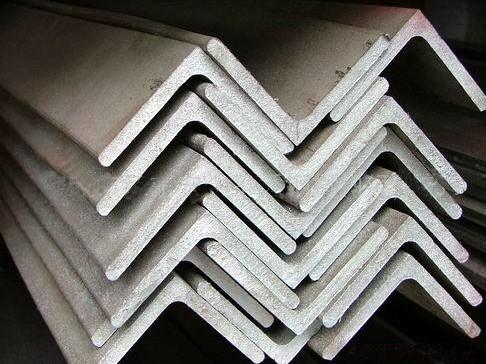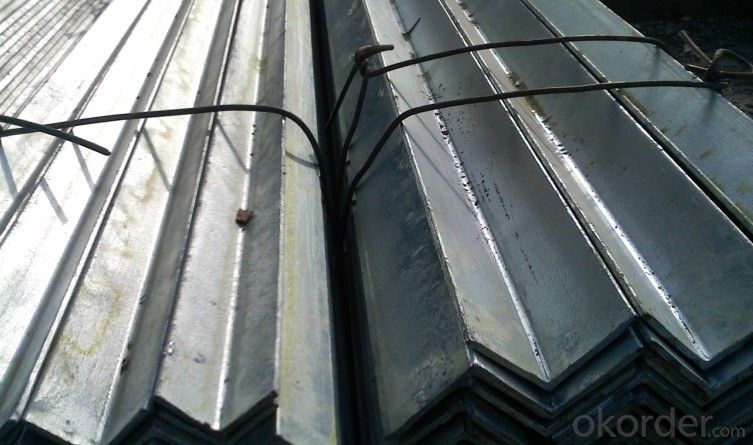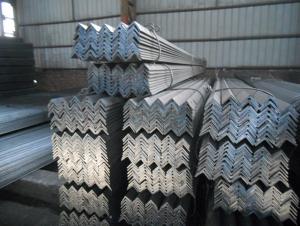Q345 Q235 equal angle steel bar AISI,ASTM,BS,GB,JIS
- Loading Port:
- Tianjin
- Payment Terms:
- TT OR LC
- Min Order Qty:
- 35 m.t.
- Supply Capability:
- 40000 m.t./month
OKorder Service Pledge
OKorder Financial Service
You Might Also Like
Specifications
1.angle steel
2.Dimensions: 20-250mm
3.Reasonable price
4.Honest attitude
5.Certificates:BUV,TUV
Company Information :
Our company is devoted to the construction of the stainless steel industry, We sincerely provide customers with quality services . Now, our products sell well in more than 20 countries and regions .
We believe that where there is a will there is a way,we assure you of a low price and the most satisfactory services.
Product Description :
Specifications
Mild angle steel
1.size: 2#--20#
2.material: Q235B,SS400,ST37-2,S235JR
3.length:6m--12m
4.Chinese standard
Specification
| Weight (kg/m) | Specification
| Weight |
25*25*3 | 1.124 | 90*90*8 | 10.946 |
25*25*4 | 1.459 | 90*90*10 | 13.476 |
30*30*3 | 1.373 | 100*100*6 | 9.366 |
30*30*4 | 1.786 | 100*100*7 | 10.83 |
40*40*3 | 1.852 | 100*100*8 | 12.276 |
40*40*4 | 2.422 | 100*100*10 | 15.12 |
40*40*5 | 2.976 | 100*100*12 | 17.898 |
45*45*3 | 2.088 | 110*110*7 | 11.928 |
45*45*4 | 2.736 | 110*110*8 | 13.532 |
45*45*5 | 3.369 | 110*110*10 | 16.69 |
50*50*3 | 2.332 | 110*110*12 | 19.782 |
50*50*4 | 3.059 | 125*125*8 | 15.504 |
50*50*5 | 3.77 | 125*125*10 | 19.133 |
50*50*6 | 4.465 | 125*125*12 | 22.696 |
63*63*5 | 4.822 | 125*125*14 | 26.193 |
63*63*6 | 5.721 | 140*140*10 | 21.488 |
63*63*8 | 7.469 | 140*140*12 | 25.522 |
70*70*5 | 5.397 | 140*140*14 | 29.49 |
70*70*6 | 6.406 | 160*160*10 | 24.729 |
70*70*7 | 7.398 | 160*160*12 | 29.391 |
70*70*8 | 8.373 | 160*160*14 | 33.987 |
75*75*5 | 5.818 | 160*160*16 | 38.518 |
75*75*6 | 6.905 | 180*180*12 | 33.159 |
75*75*7 | 7.976 | 180*180*14 | 38.383 |
75*75*8 | 9.030 | 180*180*16 | 43.542 |
75*75*10 | 11.089 | 180*180*18 | 48.634 |
80*80*6 | 7.376 | 200*200*14 | 42.894 |
80*80*7 | 8.525 | 200*200*16 | 48.68 |
80*80*8 | 9.658 | 200*200*18 | 54.401 |
80*80*10 | 11.874 | 200*200*20 | 60.056 |
90*90*6 | 8.35 | 200*200*24 | 71.168 |
90*90*7 | 9.656 |



- Q: Do steel angles have a smooth or textured surface?
- Steel angles typically have a textured surface. The texture is created during the manufacturing process when the steel is hot-rolled or cold-formed to create the angle shape. This process results in a slightly rough or bumpy surface on the steel angles, which helps to provide better grip and stability when they are used in various applications. Additionally, this texture can also help to prevent slipping or sliding of objects that come into contact with the steel angles. However, it is important to note that the level of texture may vary depending on the specific manufacturing process and the intended use of the steel angles.
- Q: Are steel angles resistant to chemical exposure?
- Yes, steel angles are generally resistant to chemical exposure. Steel is known for its high strength and durability, making it less susceptible to damage from chemical substances. However, the level of resistance can vary depending on the specific chemical and the type of steel used. In highly corrosive environments or with prolonged exposure to aggressive chemicals, certain types of steel angles may require additional protective coatings or treatments to enhance their resistance. It is always recommended to consult with experts or refer to specific material specifications to ensure the appropriate steel angles are chosen for the intended chemical exposure.
- Q: Can steel angles be used to create decorative elements in architecture?
- Definitely, decorative architectural elements can indeed be created using steel angles. These versatile angle irons can be easily manipulated to form a variety of shapes and designs. Cutting, bending, and welding them allows for the creation of intricate patterns, ornamental details, and decorative accents. Steel angles find application in various architectural features like railings, balusters, window grilles, door frames, brackets, and ornamental trims. Their strength and durability make them suitable for both indoor and outdoor use. Adding different coatings, such as paint or powder coating, can enhance their appearance and protect them from corrosion. Architects and designers often incorporate steel angles into modern and contemporary designs to impart an industrial, sleek, and minimalist touch. The clean lines and geometric shapes of steel angles bring a modern aesthetic to buildings and structures. Utilizing them to create unique and captivating patterns adds visual interest and a sense of style to architectural projects. Additionally, steel angles can be combined with other materials like glass, wood, or stone, to achieve a striking contrast and a harmonious blend of materials. This versatility offers infinite design possibilities, enabling architects to create truly personalized and distinctive decorative elements. In conclusion, steel angles can be effectively utilized to create decorative elements in architecture. Their versatility, strength, and potential for customization make them an ideal choice for architects and designers seeking to enhance the aesthetic appeal and uniqueness of their projects.
- Q: Can steel angles be used for manufacturing bike racks?
- Yes, steel angles can be used for manufacturing bike racks. Steel angles provide strength and durability, making them suitable for supporting the weight of multiple bicycles. Additionally, steel angles can be easily welded or bolted together to create a sturdy frame for the bike rack. The versatility of steel angles allows for customization and design flexibility to accommodate different types and sizes of bicycles. Furthermore, steel angles can withstand outdoor conditions and are resistant to rust and corrosion, ensuring the longevity of the bike rack. Overall, steel angles are a reliable and practical choice for manufacturing bike racks.
- Q: What are the load-bearing capacities of steel angles?
- The load-bearing capacities of steel angles vary depending on factors such as the size and thickness of the angle, the type of steel used, and the specific design and construction requirements. It is important to refer to engineering specifications, codes, and standards to determine the load-bearing capacities of steel angles for a particular application.
- Q: Can steel angles be used for HVAC systems?
- Steel angles have the capability to be utilized in HVAC systems. Due to their strength and versatility, steel angles are frequently employed in construction and engineering applications. In the realm of HVAC systems, steel angles have numerous applications including providing support for ductwork, securing equipment, and establishing ventilation system frameworks. Steel angles possess durability, corrosion resistance, and the ability to withstand the weight and pressure of HVAC components. Moreover, they can be effortlessly welded or bolted together to form personalized structures and configurations. In conclusion, steel angles are an appropriate selection for HVAC systems due to their strength, durability, and design flexibility.
- Q: What are the disadvantages of using steel angles?
- There are several disadvantages of using steel angles in various applications. One of the main disadvantages is their susceptibility to corrosion. Steel angles are typically made from carbon steel, which is prone to rusting when exposed to moisture and harsh environmental conditions. This can lead to structural weakening and reduced durability over time. Another disadvantage is their weight and bulkiness. Steel angles are often heavy and bulky, making them difficult to handle and transport. This can increase the overall cost of the project, as special equipment or additional labor may be required for installation. Steel angles also have limited flexibility and versatility in terms of design. They are typically available in standard sizes and shapes, which can restrict their use in certain applications that require custom or intricate designs. This lack of flexibility may result in additional costs for fabrication or the need for alternative materials. Additionally, steel angles can be more expensive compared to other materials such as aluminum or wood. This can make them less cost-effective in certain projects, especially in situations where the structural requirements can be met with alternative materials that are more affordable. Lastly, steel angles can conduct heat and electricity, which may not be desirable in certain applications. This can pose safety risks in electrical or heat-sensitive environments, requiring additional insulation or protective measures. Overall, while steel angles offer several advantages such as high strength and durability, their disadvantages include susceptibility to corrosion, weight and bulkiness, limited flexibility in design, higher cost, and conductivity of heat and electricity. These factors should be carefully considered when deciding whether to use steel angles in a particular project.
- Q: What are the different surface finishes available for galvanized steel angles?
- Galvanized steel angles come in a variety of surface finishes to suit different needs and preferences. 1. The smooth surface finish is the most commonly used for galvanized steel angles. It gives a polished and sleek appearance, making it suitable for various applications. 2. For those concerned about glare, a matte finish can be achieved by applying a chemical treatment to the angles. This provides a non-reflective surface. 3. Textured finishes involve adding patterns to the surface of the angles. This can be done through embossing or applying a textured coating. The textured surface not only enhances grip but also adds a decorative element. 4. Powder coating is another option for galvanized steel angles. This involves applying a dry powder to the surface and then curing it in a high-temperature oven. It offers a durable and attractive finish, with a wide range of color options available. 5. Painting is also possible for galvanized steel angles, using either oil-based or water-based paints. This adds an extra layer of protection against corrosion and can be customized to match specific color requirements. When choosing a surface finish for galvanized steel angles, it is important to consider the intended use, aesthetic preferences, and the level of protection required against corrosion. Environmental conditions and specific application needs should also be taken into account.
- Q: What is the typical lead time for steel angle orders?
- The typical lead time for steel angle orders can vary depending on multiple factors such as the supplier, quantity, customization requirements, and current market conditions. However, in general, lead times for steel angle orders tend to range between 2 to 4 weeks. This allows for the processing of the order, manufacturing or sourcing the steel angles, and transportation to the desired location. It is important to note that lead times can be influenced by factors such as availability of raw materials, production capacity, and supplier's workload. Therefore, it is advisable to contact the specific supplier or manufacturer for accurate and up-to-date lead time information.
- Q: How do you calculate the torsional capacity of a steel angle?
- To calculate the torsional capacity of a steel angle, you need to consider the material properties and dimensions of the angle. The torsional capacity refers to the maximum amount of torque or twisting force that the angle can withstand without experiencing significant deformation or failure. The torsional capacity can be determined using the following steps: 1. Determine the cross-sectional properties: Measure the dimensions of the steel angle, including the thickness, width, and length. Calculate the area moment of inertia (I) and the polar moment of inertia (J) of the cross-section. These properties provide information about the resistance of the angle to torsional forces. 2. Determine the material properties: Obtain the material properties of the steel angle, such as the yield strength (σy) and the ultimate strength (σu). These values indicate the maximum stress that the material can withstand before permanent deformation or failure occurs. 3. Calculate the torsional stress: Using the applied torque (T), calculate the torsional stress (τ) on the angle. Torsional stress is the torque divided by the polar moment of inertia (τ = T / J). This calculation determines the amount of twisting force experienced by the angle. 4. Determine the safety factor: Divide the yield strength of the material by the calculated torsional stress (SF = σy / τ). The safety factor represents the ratio of the maximum stress that the angle can withstand (yield strength) to the actual stress it experiences. A higher safety factor indicates a greater margin of safety. 5. Compare the safety factor to a desired value: Depending on the specific application and design requirements, a minimum safety factor may be specified. If the calculated safety factor is below the desired value, it indicates that the angle is not suitable for the intended torsional load and a different angle or design modification may be necessary. It is important to note that these calculations provide an estimation of the torsional capacity, and other factors such as the presence of holes, welds, or other geometric irregularities can affect the actual torsional behavior of the angle. Therefore, it is recommended to consult relevant design codes or professional engineering resources for detailed calculations and recommendations specific to your application.
Send your message to us
Q345 Q235 equal angle steel bar AISI,ASTM,BS,GB,JIS
- Loading Port:
- Tianjin
- Payment Terms:
- TT OR LC
- Min Order Qty:
- 35 m.t.
- Supply Capability:
- 40000 m.t./month
OKorder Service Pledge
OKorder Financial Service
Similar products
Hot products
Hot Searches
Related keywords



























